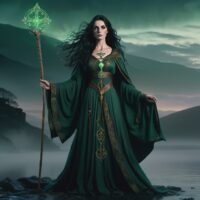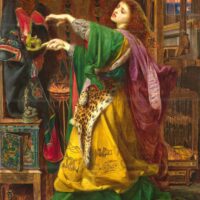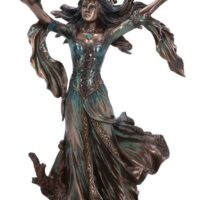Morgan le Fay : The Powerful Sorceress
Listen
At a glance
| Description | |
|---|---|
| Origin | European Mythology |
| Classification | Spirits |
| Family Members | N/A |
| Region | Igraine (Father), Gorlois (Mother), Morgause, Elaine (Siblings), Arthur (Half Brother) |
| Associated With | Sorcery, Magic |
Morgan le Fay
Introduction
Morgan le Fay, one of the most enduring characters in Arthurian legend, stands at the intersection of myth, magic, and politics. Often remembered as King Arthur’s half-sister and a powerful sorceress, her role in literature is far from static. In early accounts, she appears as a benevolent healer tied to Avalon, while later medieval romances reframe her as a dangerous antagonist, embodying betrayal and seduction. Rooted in Celtic mythology and shaped by centuries of retelling, Morgan le Fay represents both the fascination and the fear surrounding feminine power in medieval imagination. Her character bridges the world of mortals and the Otherworld, symbolizing mystery, danger, and resilience.
Physical Traits
Descriptions of Morgan le Fay vary dramatically depending on the source, reflecting the flexibility of her myth. In Geoffrey of Monmouth’s Vita Merlini (c. 1150), she is depicted as a regal and beautiful woman who rules Avalon and heals with extraordinary skill. Later romances, such as Chrétien de Troyes’ works and Malory’s Le Morte d’Arthur (1485), emphasize her elegance, often dressing her in rich gowns and veils that highlight her status and supernatural aura. Some accounts describe her hair as dark and flowing, while others portray her as fair-haired, crowned, and veiled, underscoring her shifting identity. Medieval writers often juxtaposed her beauty with her cunning, casting her as both enchanting and threatening, a visual embodiment of her role as the archetypal enchantress.
Family
Morgan le Fay’s family ties place her at the center of Arthurian drama. She is the daughter of Igraine and Gorlois of Cornwall, making her the half-sister of King Arthur, whose father is Uther Pendragon. This relationship often drives tension, as sibling loyalty clashes with rivalry. In many versions, she has two sisters—Morgause, who is linked to the birth of Mordred, and Elaine, who appears in various romances. Malory’s account gives Morgan a husband, King Urien of Gore, and a son, Sir Owain (Ywain), who serves as a Knight of the Round Table. These family connections weave her into both the domestic and political fabric of Arthurian legend, ensuring that her actions directly affect the fate of Camelot. Her myth also echoes older Celtic traditions, where powerful goddesses such as Modron or The Morrígan embody maternal strength, sovereignty, and destruction—traits Morgan herself embodies.
Other names
The many names of Morgan le Fay reveal how her identity shifted across languages and cultures. She is referred to as Morgana, Morgaine, Morgne, Morge, and even Morgue in different texts. The name Morgen first appears in Geoffrey of Monmouth’s Vita Merlini, while the epithet “le Fay” or “la Fée,” derived from Old French, emphasizes her connection to fairy lore and magic. The Italian phrase Fata Morgana eventually became associated with a natural optical illusion seen at sea, linking her legacy to the mysterious interplay between nature and the supernatural. These variations illustrate her adaptability and how storytellers reimagined her according to their own cultural frameworks.
Powers and Abilities
Morgan le Fay is consistently portrayed as a master of magical arts, though the nature of her abilities depends on the era of the text. In early stories, she is a healer with unparalleled knowledge of herbs and medicine, a role that highlights her wisdom and benevolence. As her character darkened in later traditions, she became associated with illusion, shape-shifting, necromancy, and enchantment. She could fly through the air, transform her appearance, and ensnare knights with spells of desire or deception. Malory’s Le Morte d’Arthur often casts her as Merlin’s rival, capable of creating quests, obstacles, and magical traps for Arthur’s knights. Yet even in these darker portrayals, her power is undeniable—she embodies autonomy, intellect, and an ability to operate beyond patriarchal control. This blend of healer and destroyer makes her one of the most complex figures in Arthurian literature.
Modern Day Influence
Morgan le Fay continues to thrive in modern literature, media, and cultural imagination. In the 20th century, writers and filmmakers reinterpreted her character, often reclaiming her as a misunderstood figure. Marion Zimmer Bradley’s The Mists of Avalon (1983) is perhaps the most influential modern retelling, presenting her as Morgaine, a high priestess of the Goddess, whose story reframes Arthurian legend from a female perspective. Popular culture has embraced her as well: Helen Mirren’s Morgana in John Boorman’s Excalibur (1981) remains iconic, while TV series such as Merlin (BBC, 2008–2012) and Cursed (Netflix, 2020) depict her with depth and ambiguity.
Her influence extends beyond fiction. In comics, both DC and Marvel have adapted her as a sorceress villain, while the term Fata Morgana endures in scientific vocabulary to describe a mirage, keeping her name alive in unexpected places. She has become a symbol of feminist reinterpretation, representing the suppression and reclamation of female agency in myth. By evolving from healer to villain, fairy to feminist icon, Morgan le Fay demonstrates the resilience of mythological figures who continue to inspire new generations.
Related Images
Source
Bradley, M. Z. (1983). The Mists of Avalon. New York, NY: Alfred A. Knopf.
Geoffrey of Monmouth. (1150). Vita Merlini. Retrieved from https://d.lib.rochester.edu/teams/text/geoffrey-of-monmouth-vita-merlini
Malory, T. (1485). Le Morte d’Arthur. Retrieved from https://www.gutenberg.org/ebooks/1251
Loomis, R. S. (1956). Celtic Myth and Arthurian Romance. Columbia University Press.
Larrington, C. (2015). King Arthur’s Enchantresses: Morgan and Her Sisters. In The Land of the Green Man: A Journey Through the Supernatural Landscapes of the British Isles (pp. 89–112). I.B. Tauris.
DC Comics. (n.d.). Morgan le Fay character profile. Retrieved from https://www.dc.com/characters/morgan-le-fay
Marvel. (n.d.). Morgan le Fay. Retrieved from https://www.marvel.com/characters/morgan-le-fay/on-screen
Britannica. (n.d.). Morgan le Fay. Retrieved from https://www.britannica.com/topic/Morgan-le-Fay
Frequently Asked Questions
What is lorem Ipsum?
I am text block. Click edit button to change this text. Lorem ipsum dolor sit amet, consectetur adipiscing elit. Ut elit tellus, luctus nec ullamcorper mattis, pulvinar dapibus leo.
What is lorem Ipsum?
I am text block. Click edit button to change this text. Lorem ipsum dolor sit amet, consectetur adipiscing elit. Ut elit tellus, luctus nec ullamcorper mattis, pulvinar dapibus leo.
What is lorem Ipsum?
I am text block. Click edit button to change this text. Lorem ipsum dolor sit amet, consectetur adipiscing elit. Ut elit tellus, luctus nec ullamcorper mattis, pulvinar dapibus leo.
What is lorem Ipsum?
I am text block. Click edit button to change this text. Lorem ipsum dolor sit amet, consectetur adipiscing elit. Ut elit tellus, luctus nec ullamcorper mattis, pulvinar dapibus leo.
What is lorem Ipsum?
I am text block. Click edit button to change this text. Lorem ipsum dolor sit amet, consectetur adipiscing elit. Ut elit tellus, luctus nec ullamcorper mattis, pulvinar dapibus leo.










